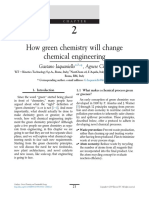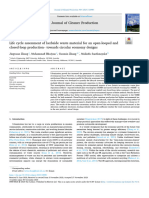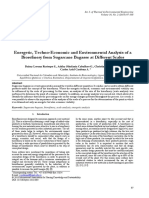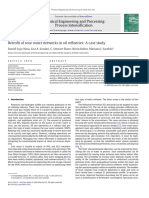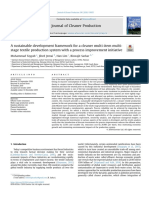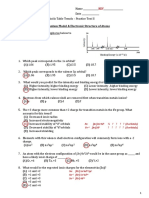Keijer 2019
Keijer 2019
Uploaded by
rafaelpulidoCopyright:
Available Formats
Keijer 2019
Keijer 2019
Uploaded by
rafaelpulidoOriginal Title
Copyright
Available Formats
Share this document
Did you find this document useful?
Is this content inappropriate?
Copyright:
Available Formats
Keijer 2019
Keijer 2019
Uploaded by
rafaelpulidoCopyright:
Available Formats
comment
Circular chemistry to enable a circular economy
By expanding the scope of sustainability to the entire lifecycle of chemical products, the concept of circular
chemistry aims to replace today’s linear ‘take–make–dispose’ approach with circular processes. This will optimize
resource efficiency across chemical value chains and enable a closed-loop, waste-free chemical industry.
Tom Keijer, Vincent Bakker and J. Chris Slootweg
A
wareness of the finite nature of many what defines a sustainable chemical process,
resources — including the issue of and needs to take into account the people,
element scarcity, shown in Fig. 1 — as planet and profit level (referred to as the Raw materials
well as the limited environmental tolerance ‘triple bottom line’)11. Notably, innovative Design
towards our chemical industry has grown chemistry designed with sustainability in
tremendously in the past few decades. mind is only effective when translated into Production,
remanufacturing
It has become painfully obvious that the economically viable applications. Recycling
Circular economy
linear route of production, in which scarce An illustrative example is the reported
resources are consumed and their value- green synthesis of adipic acid — a key Distribution
added products are degraded to waste, is component for the manufacture of nylon- Residual
waste
a route cause of several impending global 6,6 — by the direct oxidation of cyclohexene
crises such as climate change, diminished with hydrogen peroxide12. Solvent-free Collection
Consumption, use,
reuse, repair
biodiversity, as well as food, water and conditions are applied (GC 2), avoiding the
energy shortages. use of the corrosive nitric acid (GC 3)
Advocates of the circular economy and thus side-stepping the formation of Credit: European Parliament
such as The Ellen MacArthur Foundation the environmentally taxing gas nitrous
(https://www.ellenmacarthurfoundation. oxide, N2O — a waste product of the
org) cleared the path for the emergence of current industrial synthesis (GC 4). The an increase in water and air pollution, both
novel policy frameworks that aim to green method, however, requires hydrogen of which threaten to destabilize the Earth’s
redesign current economic systems, peroxide, H2O2, as starting material, which system beyond the proposed ‘planetary
exemplified by the European Union’s 2013 means that this process is currently not boundaries’ or “safe operating space” for
‘manifesto for a resource-efficient Europe’. commercially viable, since H2O2 is more anthropogenic activities14. This highlights
A circular economy is defined as “restorative expensive than the adipic acid product. the importance of looking beyond the
and regenerative by design, and aims to Although this route obeys green chemistry scientific discovery and analysing the global
keep products, components and materials at principles, it violates the value chain. As impact of chemistry using a
their highest utility and value at all times”1. a result, this green adipic acid synthesis systems approach15.
Chemistry is crucial for achieving this2–7. has not been applied industrially, and has
Chemists understand their role in designing therefore not led to an overall increase in Circular chemistry for sustainability
and developing indispensable materials sustainability. Thus, accounting for the In this Comment, we provide a holistic
and technologies, but also simultaneously profit level of the triple bottom line is an view on how chemistry can contribute to
recognize the potentially detrimental effects essential component in the design the development of a circular economy, and
that this may have on their practice; they are of sustainable chemistry. formulate twelve principles for a ‘circular
therefore becoming increasingly aware that Other chemical processes may satisfy chemistry’ (Fig. 2 and Box 2, CC 1–12). In
each step must be designed or reassessed the green chemistry principles while doing so, we provide a framework analogous
with sustainability in mind. being economically viable, yet remain to that of green chemistry, which has been
unsustainable. For example, the Haber– adapted to facilitate the transition to a
Green chemistry for linear processes Bosch process uses iron for the conversion circular economy. This approach aims to
Since it was first introduced in the 1980s, of dinitrogen, N2, into ammonia, NH3, make chemical processes truly circular
green chemistry has provided a framework which in turn is used in the production of by expanding the scope of sustainability
for teaching and performing sustainable agricultural fertilizers. It is a key industry from process optimization to the entire
chemistry, and has delivered an impetus showcase for the use of catalysts (GC 9) in lifecycle of chemical products. It promotes,
for developing cleaner products and increasing energy efficiency (GC 6). The in particular, resource efficiency across
processes8–10 — which have enhanced current process requires high temperatures chemical value chains and highlights the
chemical sustainability in industry and and pressures, and further optimization need to develop novel chemical reactions
academia. Its twelve guiding principles has stagnated. After its use as fertilizer, to reuse and recycle chemicals, to in turn
(Box 1, GC 1–12) focus on the direct large portions of the fixated nitrogen enable development towards a closed-loop,
sustainability assessment of chemical are lost to the environment, causing waste-free chemical industry16–19.
reactions, and are perfectly suited for the eutrophication, a global environmental
optimization of linear production routes. concern, the importance of which should Waste is a resource
The developments towards a circular not be underestimated13. The cascade of Regarding waste as a resource is a
economy, however, require a re-evaluation of environmental changes that results includes prerequisite for circularity. Redirecting
190 Nature Chemistry | VOL 11 | MARCH 2019 | 190–195 | www.nature.com/naturechemistry
comment
initial design of an entire process will mean
that products will lend themselves well to
being turned into separated waste-streams
at the end of their lifecycle. In turn, this
approach should enable the subsequent full
recycling of any feedstock and product.
Securing renewability
Circular chemistry seeks to replace
today’s linear ‘take–make–dispose’
approach with processes in which
materials are continuously cycled back
through the value chain for reuse,
thereby optimizing resource efficiency
and preserving finite feedstocks (CC 3).
Renewable resources offer the chemical
industry an opportunity to diversify its
raw materials base24, but ‘greenwashing’
(presenting a process or product as greener
than it actually is) should be prevented:
bio-based materials are typically classified
as being sustainable, simply because of
renewability of the resource (GC 7), yet
Fig. 1 | Periodic table representing element scarcity. In this representation of the periodic table these resources are often created in a linear
prepared by the European Chemical Society (EuChemS) for the International Year of the Periodic production process without sustainable
Table, naturally occurring elements (except some of the rarest ones beyond uranium53) are depicted end-of-life options.
through tiles, the size of which gives an indication — on a logarithmic scale — of how much of the Resource renewability alone is not a
element is present in the Earth’s crust and atmosphere. The areas are approximate for all elements and measure of sustainability. Furthermore,
exaggerated in the case of the least abundant ones shown here (technetium, promethium, polonium, if, for a given application, either oil-based
astatine, radon, francium, radium, actinium and protactinium) so that they are noticeable. Technetium plastics or bio-based plastics can be used
and promethium, shown here in white and marked as synthetic elements, do also occur naturally on (for example PET or bio-PET, produced
Earth, though only in very small amounts. This illustration highlights the speed with which elemental from mono-ethylene glycol, itself derived
supplies are being used, and draws attention to elements that are at risk of being depleted completely from agricultural products), both types of
unless recycling routes are developed, as well as those that come from countries in which wars are plastics are based on similar building blocks
fought over the ownership of the relevant mineral rights. This table mentions 31 elements (though other and their function and properties, defined
sources list other numbers, up to around 70) that are used in smart phones, which are typically replaced at the molecular level, are also alike. One
more rapidly than necessary. Credit: © EuChemS, reproduced from https://www.euchems.eu/euchems- may ask: ‘what is the difference between an
periodic-table/ under a Creative Commons license CC BY-ND 4.0 oil-based or bio-based plastic soup in our
oceans?’25,26. Unfortunately, cherry-picking
a metric (for example, here, renewability
waste streams and using them as chemical impact of the resulting waste products over recyclability and environmental
feedstocks should become ubiquitous in on the environment, novel chemical and risk) is common practice. The popular
the synthesis of marketable products biochemical conversions are urgently opinion that oil, gas and coal are harmful,
in order to achieve complete recirculation needed that allow for their efficient recovery whereas renewables are clean, removes
of molecules and materials (CC 1, and recycling. attention from the true sustainability
Box 2)20–22. It is imperative to reduce In order to succeed in eliminating or problem: material circulation. What is most
uncirculated waste in any given process reusing waste, an optimal process design important is the use of waste as a resource.
(GC 1, Box 1), yet it will not be possible to is needed that allows for the efficient Reversible polymerization could be a
eliminate degraded materials or products separation, purification, reuse and recycling major driver towards the development of
completely. Waste management will of waste products in an environmentally
therefore always be required for the effective benign way. In organic chemistry, Trost’s
circulation of materials. atom-economy concept stimulated the 1. Collect and
use waste
Eutrophication and climate change are synthetic efficiency of individual steps 12. Unify industry and
2. Maximize atom
provide coherent
two of the biggest global environmental (GC 2)23. In a similar manner, at the process policy framework circulation
concerns, largely caused by excess use level, circular chemistry targets maximizing 3. Optimize resource
11. Reject lock-in efficiency
of phosphorus and nitrogen-based atom circulation in chemical products along Circular
fertilizers, and the utilization of fossil their entire life cycles, regardless of whether 10. Sell service
not product
chemistry 4. Strive for energy
persistence
fuels, respectively. The excess of carbon chemical bonds are modified or not (Box 2, 9. Apply ladder 5. Enhance
dioxide, nitrous oxide, ammonia and CC 2). Using waste as resource presents a of circularity process efficiency
phosphate waste lost to air, water and tremendous challenge for the development 8. Assess 6. No out-of-plant
land perturbs the carbon, nitrogen and of novel chemical conversions that can cope sustainability
7. Target
toxicity
phosphorus cycles, creating a host of adverse with complex waste mixtures as feedstocks optimal design
environmental impacts14. To mitigate these for the production of value-added molecules
environmental concerns and reduce the and materials. Addressing this during the Fig. 2 | The twelve principles of circular chemistry.
Nature Chemistry | VOL 11 | MARCH 2019 | 190–195 | www.nature.com/naturechemistry 191
comment
chemistry, circular chemistry strives
Box 1 | The twelve principles of green chemistry (GC)8
to reduce the harmful impact of these
compounds on the environment. Although
1. Prevent waste. It is better to 7. Use renewable feedstocks. A raw the use of substances of concern may be
prevent waste than to treat or material or feedstock should be renewable unavoidable at some facilities35, these should
clean up waste after it has been rather than depleting. not be released to the environment (CC 6).
created. This approach requires the continued
8. Reduce chemical derivatives. Reduce conglomeration of industrial sites and
2. Maximise atom economy. Chemical generation of derivatives, since such enhanced cooperation between companies.
processes should maximize incorporation chemical steps require more reagents and Optimal product design should target
of all materials used into the final produce additional waste. the most favourable end-of-life state,
product. avoiding persistence in the environment and
9. Use catalytic (versus stoichiometric) breakdown into harmful products (CC 7).
3. Less hazardous synthesis. Chemical conditions. Using catalysts is preferable Biodegradable materials are often seen as
processes should avoid using or producing compared to using reagents in sustainable — yet the fact that the product
substances toxic to humans and the stoichiometric amounts. can simply be disposed of in the environment
environment. may promote littering. Another issue
10. Design for degradation. Chemical often overlooked is that micro plastics and
4. Design benign chemicals. products should be designed to deteriorate polymers partially degraded from a plastic
Chemicals should be designed to achieve after fulfilling a function without persisting bottle cause more harm to the environment
their function while minimizing their in the environment. than the original bottle26,36. Here, again,
toxicity. following the green chemistry principles that
11. Real-time analysis for pollution encourage chemists to design materials for
5. Use safer solvents and auxiliaries. prevention. Analytical methods allow degradation (GC 10) does not unequivocally
Auxiliary substances should be rendered in-process monitoring and control prior to lead to an increase in sustainability.
redundant wherever possible and harmless the formation of hazardous substances. Therefore, rather than aiming for product
when used. degradation, it is preferable to collect
12. Minimize potential for accidents. waste streams and instead convert them in
6. Increase energy efficiency. Energy Substances used in a chemical process dedicated plants into value-added materials.
requirements of chemical processes should should be chosen to minimize the potential
be minimized. for accidents. The life cycle assessment and the
ladder of circularity
Environmental assessments, typified by the
life cycle assessment (LCA), which assesses
renewable plastics. A few examples of such additional energy inputs. Constant the impact on the environment of the entire
plastics that display comparable properties innovation is required to promote the life cycle of a chemical product, should
to conventional plastics yet can be returned recycling (and therefore the separation) of become prevalent to identify inefficiencies
to their monomeric form have been materials during both a chemical process in current chemical processes (CC 8)37,38.
developed that may reshape product and the collection of the desired products. Such sustainability metrics, which provide
life cycles27–30. These ‘in-process’ developments are information on the environmental impact of
followed by ‘post-process’ developments, as a chemical from its design to its disposal39,40
Energy input is an investment the repurposing of the consumed products can help to identify opportunities for
Using waste as a resource can also contribute through chemical or biochemical methods innovation in a process and can also
considerably to the energy efficiency of a (CC 5) is required to reduce primary pinpoint which feedstock is most sustainable
chemical product over its entire life cycle31,32. feedstock use, optimize resource yields and to use as resource.
In order to repurpose waste material into increase renewability, durability and multi- Resource hierarchy (Fig. 3) urges that
a feedstock, it is important to achieve a functionality of chemicals and products. the necessity of material use is examined
recirculation of molecules and materials that There is a strong ambition towards by asking the following questions: ‘Do we
ensure an energy economy33. For example, developing chemically renewable energies, need this material to achieve our goal?’, ‘Do
CO2 can be converted into a variety of for example, solar-driven chemistry. we need to make something new or can
other molecules (ranging from methane to Meanwhile, the energy invested in chemical available material be reused or repaired?’,
alcohols to amides), which can, in turn, be products should be retained as much and ‘Does the used product really need to
used for a variety of purposes — but the as possible during circulation. Energy, be disposed of?’. The actions associated
conversion process shouldn’t necessitate ultimately derived from natural sources, will with these questions are summarized
more energy than that offered by the always be required for the transportation in the ladder of circularity (reject, reduce,
product obtained (CC 4). and processing of materials to enable the full reuse, redistribute, repair, refurbish,
This emphasis on the reusability of recycling of all chemical elements, especially repurpose, remanufacture, recycle, recover,
materials means that their longevity — those that are in limited supply. return, which can be referred to as the
which requires they remain chemically ‘11 Rs’)41,42 that provides a means by which
stable over many product cycles — is valued Controlled environment to assess the end-of-life options (CC 9).
over their degradability (GC 10)34. By The inherent reactivity of chemicals When considering the various routes
viewing the energy stored in materials as a enables their conversion into value-added of circulation, it is required to aim for
long-term investment, circular chemistry compounds, but can also lead to adverse the highest possible forms of recycling
aims to conserve energy, and thus reduces effects. In a similar manner to green (shown at the top of the ladder). The most
192 Nature Chemistry | VOL 11 | MARCH 2019 | 190–195 | www.nature.com/naturechemistry
comment
desirable courses of action are to avoid or
Box 2 | The twelve principles of circular chemistry (CC)
prevent use of resources. Redistribution
(reintroducing a used product in a new
market) is placed slightly lower than reuse 1. Collect and use waste. Waste is accounting for separation, purification and
(a widespread example of which is a library) a valuable resource that should be degradation.
because reusing products in the same transformed into marketable products.
location doesn’t require transportation. At 2. Maximize atom circulation. 8. Assess sustainability. Environmental
the bottom of the ladder, the least desirable Circular processes should aim to assessments (typified by the LCA) should
options are landfill dumping or incineration maximize the utility of all atoms in become prevalent to identify inefficiencies
of materials as waste. It is true that existing molecules. in chemical processes.
incineration as a disposal method generates
heat, which can be used as energy, but this 3. Optimize resource efficiency. 9. Apply ladder of circularity. The end-
should be the last resort when there are no Resource conservation should be targeted, of-life options for a product should strive
viable recycling options. promoting reuse and preserving finite for the highest possibilities on the ladder of
It is important to account for material feedstocks. circularity.
separation, purification and degradation to
sustain chemical processes. An example of 4. Strive for energy persistence. Energy 10. Sell service, not product. Producers
aiming to redesign products for a circular efficiency should be maximized. should employ service-based business
economy while recognizing the triple models such as chemical leasing,
bottom line is the joint venture between 5. Enhance process efficiency. Innovations promoting efficiency over production rate.
Dutch State Mines (DSM) and Niaga should continuously improve in- and
(whose name stems from the backwards post-process reuse and recycling, 11. Reject lock-in. Business and regulatory
spelling of ‘again’). The venture’s first project preferably on-site. environment should be flexible to allow the
was the redesign of the carpet-making implementation of innovations.
process, which has been identified as a 6. No out-of-plant toxicity. Chemical
huge contributor to landfill in the United processes should not release any toxic 12. Unify industry and provide coherent
States and European countries. Separation compounds into the environment. policy framework. The industry and
and recycling of glued carpet was never policy should be unified to create an
economically viable; instead, DSM–Niaga 7. Target optimal design. Design should optimal environment to enable circularity
now produce their entire carpets out of be based on the highest end-of-life options, in chemical processes.
the same material (polyester) and have
also developed a reversible glue that allows
carpets consisting of two different materials
to be taken apart. This is an example where their painting operations, the companies quo of continued process optimization
chemical innovation turned an everyday devised a process in which expenses were — it is simply easier to keep relying on
product in a fully recyclable one, where the charged per square metre of metal material the established system of production and
waste has value (as another carpet). coated, and powder waste was returned to consumption through, for example, chemical
AkzoNobel for recycling. The arrangement plants and companies. When business-as-
Product stewardship also included the training of workers, usual is preferred over conceptually novel
The circular economy relies on a decoupling resulting in products of better quality and a means of providing a service because of the
of material consumption and economic reduction in the number of reject products, financial cost of adopting the new approach,
growth43. To promote this, ownership of as well as a reduction in maintenance which often involves the necessary
goods needs to be directed away from the costs. The resulting process is closed-loop, development of supporting technology and
user and back to the producer. This can be generates nil waste, and ABB ARAB saw a infrastructure, the situation can be referred
achieved by shifting payment models from 20% reduction in coating used. A service- to as a ‘lock-in’45–48. Therefore, circular
ownership-based to service-based systems based chemical industry is vital to circular chemistry innovations also need to promote
— an example is the use of shared cars. chemistry, as companies have the assets and transitions and overcome lock-ins to
Similarly, in circular chemistry, producers the know-how to retrieve and repurpose realize market opportunities for long-term
are encouraged to use service-based chemical products, and the chemical sustainability ambitions (CC 11). A chemical
business models (such as chemical leasing, industry is far better equipped to target innovation befitting circular chemistry
www.chemicalleasing.org)44 to promote the management of molecule-circulating yields a process that is both flexible and
efficiency and longevity of the materials over loops — for example infrastructure for the adaptive. Companies can prevent lock-
production rate and quantity, and to shift reuse or recycling of materials (a step called ins by focusing on entrepreneurs and
the focus towards a value-added approach ‘reverse logistics’) — than the user. This type creating space for change in their available
targeting the service that is linked with of industry will lead to the more efficient infrastructure from the start.
the chemicals. use of chemicals and to the improved health Finally, in order to facilitate the adoption,
A successful example of this approach and safety, environmental and economic development and implementation of circular
can be found in Egypt. Asea Brown Boveri benefits (CC 10). chemistry, a supportive policy framework
(ABB) ARAB is a manufacturer of electrical is also required (CC 12) to ensure that the
appliances, who resolved high costs in Circumventing lock-ins value chain is balanced over the whole
electrostatic powder coating by collaborating Transitioning towards a circular economy cycle of materials circulation. Key drivers
with paints and coatings supplier AkzoNobel requires immediate action. Currently, to induce this transition are: enabling and
from 2008. Instead of ABB ARAB buying moving to more sustainable chemical rewarding chemical and environmental
the coating material per kilogram for processes is often limited by the status regulations; sustainable supply chains and
Nature Chemistry | VOL 11 | MARCH 2019 | 190–195 | www.nature.com/naturechemistry 193
comment
LEVELS OF THE
RESOURCE HIERACHY LEVEL DEFINITION
Rejection has an effect on the take-stage.
By preventing the usage of material or energy
resources they do not need to be mined. It is
Reject considered the highest level of the hierarchy.
Prevent food loss Simplify
Reduction is generally about turning down the
Lengthen product life
tap. You still use some resources, but fewer through
Reshore the simplification of the product, increased product
Reduce Reshore life span and reduced distance for transport.
The library is the most common example of reuse.
Share product This level is about reuse on a local level, for
example through sharing or leasing. Little
Reuse transport is necessary.
Product-service
Distribute as human food Redistribution is also about reusing resources,
(food bank) but more transport is needed. For example,
reintroducing a second-hand product in a new
Redistribute market.
Reintroduce
Once resources are broken but in their fixed
state are still valuable, repairing and maintenance
Maintain product
are generally the least resource-intensive solutions
Repair to extend the life of resources.
For electronic materials, refurbishment means
Convert to combining repaired and redistributed products.
human food In many other cases, it means updating a product to
Refurbish the current standards.
Convert to Cascade parts Repurposing is the updating or adaptation of a product
animal feedstock such that it can be used to serve a new function
Repurpose or within another context.
Convert to
industry feedstock
Remanufacture is generally a more thorough
process of disassembling a product, replacing worn
Remanufacture and broken parts with new ones and reassembling it.
Recycle is a term often used for the simple reuse
of materials. It also comprises the process
of liquifying materials (such as smelting)
Recycle to act as a feedstock for new material production.
Compost to fertilizer
Recovery is retrieving the lowest forms of
Anaerobic digestion energy or feestock for energy production from a
material. The actual material is broken down and
Sustainable energy Recover cannot be recycled further.
resource Incineration
Most hierarchies call this landfill. However, this
stage is more than that; it encompasses the return
of solids, but also liquids and gases, back to the
Return Sequestration environment after use.
BIOLOGICAL TECHNICAL
MATERIALS Resource separation MATERIALS
Fig. 3 | A comprehensive illustration of the resource hierarchy. The widely known ‘3 Rs’ approach — reduce, reuse and recycle — has been expanded and
throughout the past few decades a variety of ladders and scales have been used to represent this concept. Figure 3 serves as a visual guide to help the
understanding and application of the ‘11 Rs’, depending in particular on the types of materials being used (biological versus technical ones). Whereas biological
materials can largely be regenerated, this is not the case for human-made materials, and so for efficient waste management these different types of resources
should be kept separate as much as possible. Credit: Maurits Korse, https://blog.mauritskorse.nl/en/2016/01/waste-hierarchy-explained/
194 Nature Chemistry | VOL 11 | MARCH 2019 | 190–195 | www.nature.com/naturechemistry
comment
chemical logistics (https://tfs-initiative. of Amsterdam, Science Park 904, Amsterdam, 29. The future of plastic. Nat. Commun. 9, 2157 (2018).
30. Kaur, G., Uisan, K., Ong, K. L. & Lin, C. S. K. Curr. Opin. Green
com)49; and optimal university–industry– Netherlands. Sust. Chem. 9, 30–39 (2018).
government relations (which has been Twitter handle: @ChrisSlootweg 31. Patt, J. J. & Banholzer, W. F. The Bridge 39, 15–22 (2009).
referred to as the ‘triple helix’)50. *e-mail: j.c.slootweg@uva.nl 32. Facts & Figures 2018 of the European Chemical Industry
(Cefic, 2018).
33. Das Neves Gomes, C. et al. Angew. Chem. Int. Ed. 51,
Conclusions Published online: 21 February 2019 187–190 (2012).
Within our linear economy, green https://doi.org/10.1038/s41557-019-0226-9 34. Figge, F., Stevenson Thorpe, A., Givry, P., Canning, L. &
Franklin-Johnson, E. Ecol. Econ. 150, 297–306 (2018).
chemistry has allowed the optimization References 35. Chemicals and the Circular Economy: Dealing with Substances of
of chemical processes, leading to less 1. Stahel, W. R. Nature 531, 435–438 (2016). Concern (European Parliament, 2017).
environmentally demanding chemistry 2. Matlin, S. A., Mehta, G., Hopf, H. & Krief, A. Nat. Chem. 7, 36. Hurley, R., Woodward, J. & Rothwell, J. J. Nat. Geosci. 11,
251–257 (2018).
practices. In doing so, it has laid the 941–943 (2015).
37. Mulvihill, M. J., Beach, E. S., Zimmerman, J. B. & Anastas, P. T.
3. Clark, J. H., Farmer, T. J., Herrero-Davila, L. & Sherwood, J. Green
groundwork for an environmentally friendly Chem. 18, 3914–3934 (2016). Annu. Rev. Environ. Resour. 36, 271–293 (2011).
culture in the chemical discipline. Now, 4. Anastas, P. T. & Zimmerman, J. B. Chem. 1, 10–12 (2016). 38. Sustainability hotspot scan: Sustainability opportunities and
risks for the chemical value chain. TNO https://go.nature.
further steps need to be taken towards 5. Sheldon, R. A. Green Chem. 18, 3180–3183 (2016).
com/2UvZURB (2019).
6. Kümmerer, K. Angew. Chem. Int. Ed. 56, 16420–16421 (2017).
sustainability. With the development of 7. Linder, M. Green Chem. Lett. Rev. 10, 428–435 (2017). 39. Constable, D. J. C., Jiménez-González, C. in Handbook of
a circular economy, we introduce a set 8. Anastas, P. T & Warner, J. C (eds) in Green Chemistry: Theory and Green Chemistry: Green Synthesis Vol. 7 (eds Chao-Jun, L. &
of principles for sustainable chemistry Practice (Oxford University Press, 1998). Anastas, P. T) 69–92 (Wiley-VCH, 2012).
9. Marteel-Parrish, A. E. & Abraham, M. A. (eds) Green Chemistry and 40. Saidani, M., Yannou, B., Leroy, Y. & Cluzel, F. Recycling 2,
practice that is analogous to those of Engineering: A Pathway to Sustainability (Wiley, Hoboken, 2014). 6 (2017).
green chemistry, and introduce the term 10. Erythropel, H. C. et al. Green Chem. 20, 1929–1961 (2018). 41. Korse, M. Resource hierachy explained. Facio https://go.nature.
circular chemistry. 11. Elkington. J. 25 years ago I coined the phrase “Triple bottom line.” com/2UkLTFW (2016).
Here’s why it’s time to rethink it. Harvard Business Review https:// 42. Lansink, A. Waste Manag. Res. 36, 872 (2017).
Circular chemistry offers a holistic go.nature.com/2DfwKPk (2018). 43. Raworth, K. Doughnut Economics. (Cornerstone, London, 2017).
systems approach: by making chemical 12. Sato, K., Aoki, M. & Noyori, R. Science 281, 1646–1647 (1998). 44. Moser, F. & Jakl, T. Environ. Sci. Pollut. Res. Int. 22,
processes truly circular, products can — 13. Erisman, J. W., Sutton, M. A., Galloway, J., Klimont, Z. & 6325–6348 (2015).
Winiwarter, W. Nat. Geosci. 1, 636–639 (2008). 45. Suurs, R. & Roelofs, E. Systemic Innovation: Concepts and Tools
ideally — be repurposed near-indefinitely, 14. Steffen, W. et al. Science 347, 1259855 (2015). for Strengthening National and European Eco-policies https://
with energy as the only input. The chemical 15. Matlin, S. A., Mehta, G., Hopf, H. & Krief, A. Nat. Chem. 8, go.nature.com/2DbanuB (TNO, 2014).
sector has the opportunity to take a 393–398 (2016). 46. Frantzeskakia, N. & Loorbach, D. Technol. Forecast. Soc. Change
77, 1292–1301 (2010).
leading role in combatting scarcity and 16. Cavani, F., Centi, G., Perathoner, S. & Trifiró, F. (eds) Sustainable
47. Etzkowitz, H. & Leydesdorff, L. Res. Policy 29, 109–123 (2000).
Industrial Chemistry (Wiley-VCH, Weinheim, 2009).
environmental crises as a result of ineffective 17. Nuijten, B. No time to waste: the state of the circular economy 48. Governments going Circular – Global Scan Best Practices.
waste management, as the development of innovation within the chemical industry. Finch & Beak https:// De Groene Zaak http://www.govsgocircular.com (2019).
49. Reniers, G. L. L., Sörensen, K. & Vrancken, K. Management
novel chemical reactions to reuse molecules go.nature.com/2UlCbmM (2016).
Principles of Sustainable Industrial Chemistry: Theories, Concepts
18. Elser, B. & Ulbrich M. Taking the European chemical industry
and materials will lead to a closed-loop into the circular economy. Accenture https://go.nature. and Industrial Examples for Achieving Sustainable Chemical
chemical industry. Life cycle thinking and com/2DE4Uh6 (2017). Products and Processes from a Non-Technological Viewpoint
circularity will reinvent chemistry51, and 19. Accelerating Europe Towards a Sustainable Future (Wiley-VCH, Weinheim, 2013).
(ChemistryCAN, Cefic, 2017). 50. Blum, C. et al. Sustainable Chem. Pharm. 5, 94–104 (2017).
should be the basic principles for developing 20. Behr, A. & Johnen L. in Handbook of Green Chemistry: Green 51. Whitesides, G. M. Angew. Chem. Int. Ed. 54, 3196–3209 (2015).
novel chemical products and processes Synthesis Vol. 7(eds Chao-Jun, L. & Anastas, P. T) 69–92 52. Transforming our world: the 2030 Agenda for Sustainable
that use waste as resource. In turn, this will (Wiley-VCH, 2012). Development. Sustainable Development Goals Knowledge Platform
21. Clark, J. H. Curr. Opin. Green Sust. Chem. 8, 10–13 (2017). https://go.nature.com/2FWSseG (2015).
contribute to realizing the circular economy 22. Olivetti, E. A. & Cullen, J. M. Science 360, 1396–1398 (2018). 53. Thornton, B. F. & Burdette, S. C. Nat. Chem. 11, 4–10 (2019).
and securing our sustainable future by 23. Trost, B. M. Science 254, 1471–1477 (1991).
addressing the United Nations Sustainable 24. Bender, T. A., Dabrowski, J. A. & Gagné, M. R. Nat. Rev. Chem. 2, Acknowledgements
35–46 (2018).
Development Goals52. ❐ 25. Greene, J. P. Sustainable Plastics: Environmental Assessments of
This work was supported by the Council for Chemical
Sciences of The Netherlands Organization for Scientific
Biobased, Biodegradable, and Recycled Plastics (Wiley,
Research (NWO/CW and NWO/TTO) by a VIDI grant
Tom Keijer1, Vincent Bakker1 and Hoboken, 2014).
26. Iwata, T. Angew. Chem. Int. Ed. 54, 3210–3215 (2015). (J.C.S.) and a STW Take-off grant (J.C.S.). We gratefully
J. Chris Slootweg1* acknowledge the MChem Green Chemistry class of 2016
27. Zhu, J.-B., Watson, E. M., Tang, J. & Chen, E. Y.-X. Science 360,
1
Van ‘t Hoff Institute for Molecular Sciences, Research 398–403 (2018). and 2017 and D. Appel (Index Initiative) and T. Cantat
Priority Area Sustainable Chemistry, University 28. Sardon, H. & Dove, A. P. Science 360, 380–381 (2018). (CEA Saclay) for stimulating discussions.
Nature Chemistry | VOL 11 | MARCH 2019 | 190–195 | www.nature.com/naturechemistry 195
You might also like
- Circularity Indicators An Approach To Measuring Circularity: Project OverviewDocument12 pagesCircularity Indicators An Approach To Measuring Circularity: Project OverviewFilena Rubio100% (2)
- CEFIC Quantis Report FinalDocument24 pagesCEFIC Quantis Report FinalJayanth KumarNo ratings yet
- Battista 2020Document18 pagesBattista 2020Ingryd Mayer KrinskiNo ratings yet
- Macro Chemistry Physics - 20hvbhiojDocument17 pagesMacro Chemistry Physics - 20hvbhiojCarlo TonelloNo ratings yet
- Sustainability in Catalytic Oxidation: An Alternative Approach or A Structural Evolution?Document27 pagesSustainability in Catalytic Oxidation: An Alternative Approach or A Structural Evolution?JoanneLimNo ratings yet
- Lignocellulosic Agricultural Waste Valorization To Obtain Valuable Products: An OverviewDocument46 pagesLignocellulosic Agricultural Waste Valorization To Obtain Valuable Products: An Overview0364gorditoNo ratings yet
- 1-S2.0-S2212827115001596-Waste ManagementDocument6 pages1-S2.0-S2212827115001596-Waste Managementharis.accessNo ratings yet
- 19 - DFR - Systematic Integration of Design-For-Recycling Into Product Design (1995)Document8 pages19 - DFR - Systematic Integration of Design-For-Recycling Into Product Design (1995)Aleena KanwalNo ratings yet
- Techno Analysis Method Writing ExampleDocument22 pagesTechno Analysis Method Writing Examplestructuredes.1No ratings yet
- 1 s2.0 S2772826922000074 MainDocument18 pages1 s2.0 S2772826922000074 MainRajdeep MallickNo ratings yet
- Biogas 1Document24 pagesBiogas 1Sherin Novia Dwi PareraNo ratings yet
- Energies 15 01475 v2Document21 pagesEnergies 15 01475 v2José CoelhoNo ratings yet
- Product Disposal PenaltyDocument16 pagesProduct Disposal PenaltyAbhinay BayyapuNo ratings yet
- Evaluation - of - A - Three Step - Process - For - t20160214 30388 1j4lccs With Cover Page v2Document8 pagesEvaluation - of - A - Three Step - Process - For - t20160214 30388 1j4lccs With Cover Page v2Bad boyNo ratings yet
- Dereszewska y Cytawa, 2023Document12 pagesDereszewska y Cytawa, 2023YONIER FELIPE BARRERA FIGUEROANo ratings yet
- Design For Circularity - Identification of Fields of Action For Ecodesign For The Circular EconomyDocument6 pagesDesign For Circularity - Identification of Fields of Action For Ecodesign For The Circular EconomyBilly ShevriyantoNo ratings yet
- Environmental and Economic Analysis of Power Generation in A Thermophilic Biogas PlantDocument11 pagesEnvironmental and Economic Analysis of Power Generation in A Thermophilic Biogas PlantmfernandezkvNo ratings yet
- Sustainable Wastewater Management and TRDocument4 pagesSustainable Wastewater Management and TRMet HasanNo ratings yet
- Lecture - Design For EnvironmentDocument23 pagesLecture - Design For EnvironmentParth ChauhanNo ratings yet
- WastepreventionDocument9 pagesWastepreventionaanitahpNo ratings yet
- Circular Handbook For Real Estate ProfessionalsDocument17 pagesCircular Handbook For Real Estate ProfessionalsLuis Miguel PereiraNo ratings yet
- How Green Chemistry Will Change Chemical Engineering: Gaetano Iaquaniello, Agnese CicciDocument14 pagesHow Green Chemistry Will Change Chemical Engineering: Gaetano Iaquaniello, Agnese CicciFabianNo ratings yet
- 1 s2.0 S2452223621000705 MainDocument6 pages1 s2.0 S2452223621000705 MainYoya LoyaNo ratings yet
- Applsci 12 01917 v2Document20 pagesApplsci 12 01917 v2Nathanael Basana HisarNo ratings yet
- 1 s2.0 S2214799322001771 MainDocument6 pages1 s2.0 S2214799322001771 Mainsteve westNo ratings yet
- Nwad 193Document2 pagesNwad 193kai06071eNo ratings yet
- Chen 2021Document15 pagesChen 2021Michelle NatasyaNo ratings yet
- Broadbent2016 Article SteelSRecyclabilityDemonstratiDocument8 pagesBroadbent2016 Article SteelSRecyclabilityDemonstratimichaelNo ratings yet
- Spent Coffee Waste As A Renewable Source For The PDocument10 pagesSpent Coffee Waste As A Renewable Source For The Pzahiasarni1998No ratings yet
- Waste To EnergyDocument11 pagesWaste To EnergyshaielNo ratings yet
- Rpa Chemical Recycling StatementDocument5 pagesRpa Chemical Recycling StatementPruthvi Mundalamane JagadishchandraNo ratings yet
- Biodiesel Production From Vegetable OilDocument7 pagesBiodiesel Production From Vegetable OilHamza FerkousNo ratings yet
- 2019 - 07 - Ebook Circular Economy PlasticsaimplasDocument18 pages2019 - 07 - Ebook Circular Economy PlasticsaimplasSébastien MermetNo ratings yet
- 27 - Modeling - and - Simulation - of - Biomass - Anaerobic - DigesDocument12 pages27 - Modeling - and - Simulation - of - Biomass - Anaerobic - DigesslmokraouiNo ratings yet
- Journal of Cleaner Production: Jingxuan Zhang, Muhammad Bhuiyan, Guomin Zhang, Malindu SandanayakeDocument19 pagesJournal of Cleaner Production: Jingxuan Zhang, Muhammad Bhuiyan, Guomin Zhang, Malindu SandanayakeSNEHAL GUPTANo ratings yet
- Solid Waste Management in Petroleum RefineriesDocument9 pagesSolid Waste Management in Petroleum RefineriesThiyagaraj RamanNo ratings yet
- Combined Treatment of Domestic and Pulp and Paper Industry WastewaterDocument10 pagesCombined Treatment of Domestic and Pulp and Paper Industry Wastewaterjsaswini6No ratings yet
- Identification Hotspot Green House Gases EmissionDocument8 pagesIdentification Hotspot Green House Gases EmissionProsie VNo ratings yet
- Addressing The Challenges of Plastic Pollution, Including in The Marine Environment, Using Circular Economy MethodsDocument72 pagesAddressing The Challenges of Plastic Pollution, Including in The Marine Environment, Using Circular Economy MethodsArooj FatimaNo ratings yet
- Renewable Energy: Nur Izzah Hamna A. Aziz, Marlia M. Hana FiahDocument11 pagesRenewable Energy: Nur Izzah Hamna A. Aziz, Marlia M. Hana Fiahagungtiyo21No ratings yet
- Jurnal 1Document6 pagesJurnal 1RatriNo ratings yet
- Life Cycle and Techno-Economic Assessment of Bioresource Production From WastewaterDocument17 pagesLife Cycle and Techno-Economic Assessment of Bioresource Production From WastewaterRifyal MulkanNo ratings yet
- Knowledge 03 00001Document17 pagesKnowledge 03 00001Park JiminNo ratings yet
- Sustainable Energy Generation From Municipal Solid Waste: A Brief Overview of Existing TechnologiesDocument8 pagesSustainable Energy Generation From Municipal Solid Waste: A Brief Overview of Existing TechnologiesZaki KhanNo ratings yet
- Sistemasdereactores 9349Document8 pagesSistemasdereactores 9349IlireaNo ratings yet
- Perspectives: Green Chemistry: A Tool For The Sustainable Development of The Chemical IndustryDocument2 pagesPerspectives: Green Chemistry: A Tool For The Sustainable Development of The Chemical IndustryRodolfo Angulo OlaisNo ratings yet
- 1.8 - An Introductory Note On The Environmental Economics of The Circular EconomyDocument9 pages1.8 - An Introductory Note On The Environmental Economics of The Circular EconomyKaroline Brito Coutinho FerreiraNo ratings yet
- Extended Abstract Beatriz Matafome FINALDocument11 pagesExtended Abstract Beatriz Matafome FINALnebex12No ratings yet
- Coupling Dark Fermentation and Microbial Electrolysis To Enhance Bio-Hydrogen Production From Agro-Industrial Wastewaters and By-Products in A Bio-Refinery FrameworkDocument13 pagesCoupling Dark Fermentation and Microbial Electrolysis To Enhance Bio-Hydrogen Production From Agro-Industrial Wastewaters and By-Products in A Bio-Refinery FrameworkBENGUERBA YacineNo ratings yet
- Polymers 15 00859Document10 pagesPolymers 15 00859Olatz PalmaNo ratings yet
- Process Design For Integration of Extraction, Purification and Formulation (Sixt Et Al., 2016)Document16 pagesProcess Design For Integration of Extraction, Purification and Formulation (Sixt Et Al., 2016)Amit AggarwalNo ratings yet
- AIChE Journal - 2020 - Zhao - Waste High Density Polyethylene Recycling Process Systems For Mitigating Plastic PollutionDocument25 pagesAIChE Journal - 2020 - Zhao - Waste High Density Polyethylene Recycling Process Systems For Mitigating Plastic PollutionAhmet AltunNo ratings yet
- Enhancement of Production and Upgradation of Biogas Using Different Techniques-A ReviewDocument17 pagesEnhancement of Production and Upgradation of Biogas Using Different Techniques-A ReviewZainul Fikri TampengNo ratings yet
- Sour Water Cost FlowDocument10 pagesSour Water Cost FlowSAMEUT BOUHAIK IzzeddineNo ratings yet
- 1 s2.0 S0016236123029125 MainDocument13 pages1 s2.0 S0016236123029125 Mainfajar marendraNo ratings yet
- Journal of Cleaner Production: Muhammad Tayyab, Jihed Jemai, Han Lim, Biswajit SarkarDocument20 pagesJournal of Cleaner Production: Muhammad Tayyab, Jihed Jemai, Han Lim, Biswajit SarkarahtashamNo ratings yet
- Importance of Condensate Recovery in Industrial Operations "AMOC CASE"Document11 pagesImportance of Condensate Recovery in Industrial Operations "AMOC CASE"International Journal of Innovative Science and Research TechnologyNo ratings yet
- Gasia aDocument17 pagesGasia aALIZAIDINo ratings yet
- 1 s2.0 S2590174521000969 MainDocument16 pages1 s2.0 S2590174521000969 MainMd ShihabuzzamanNo ratings yet
- Carbon Capture-Utilization and Storage: Climate Change MitigationFrom EverandCarbon Capture-Utilization and Storage: Climate Change MitigationNo ratings yet
- AEFAC Design of Fasteners To AS5216Document31 pagesAEFAC Design of Fasteners To AS5216EliseNo ratings yet
- DPPH Radical Scavenging AssayDocument20 pagesDPPH Radical Scavenging AssayBeatriz FriasNo ratings yet
- TDS-Argacel TCW (V4) Bluesign - 549Document3 pagesTDS-Argacel TCW (V4) Bluesign - 549Amberdeep SinghNo ratings yet
- Model Direct Mount, Cross Pilot: Cavity: T-17ADocument4 pagesModel Direct Mount, Cross Pilot: Cavity: T-17AenovanovaNo ratings yet
- Part 1 General Education 150 Questions With AnswersDocument11 pagesPart 1 General Education 150 Questions With Answersednamuloc9No ratings yet
- ElectroChem NotesDocument8 pagesElectroChem Noteskyledang277No ratings yet
- CH 7 Dislocations and Strengthening Mechanisms 1Document74 pagesCH 7 Dislocations and Strengthening Mechanisms 1Nasser SA100% (1)
- USDA Buffering Capacity Study Dr. Fred BreidtDocument27 pagesUSDA Buffering Capacity Study Dr. Fred Breidtheda amNo ratings yet
- Title: Preparation of Nanocatalyst in Petrochemical IndistriesDocument5 pagesTitle: Preparation of Nanocatalyst in Petrochemical IndistriesChris AngNo ratings yet
- Schwald, W. Dan Bobleter, O. Hydrothermolysis of Cellulose Under Static and Dynamic Conditions at High TemperaturesDocument15 pagesSchwald, W. Dan Bobleter, O. Hydrothermolysis of Cellulose Under Static and Dynamic Conditions at High TemperaturesAdhan AkbarNo ratings yet
- Solvation Effects On Quantum Tunneling ReactionsDocument11 pagesSolvation Effects On Quantum Tunneling ReactionsZdeněk ChvalNo ratings yet
- CHEMISTRY Practice Exam 3Document5 pagesCHEMISTRY Practice Exam 3Arianne DiosoNo ratings yet
- Emulsion - Wacker E 3154 TDSDocument1 pageEmulsion - Wacker E 3154 TDSAngga PratamaNo ratings yet
- 6.) Chemical-Properties - CLORESSheenBSEE3BDocument12 pages6.) Chemical-Properties - CLORESSheenBSEE3BCymon S. ManzanaNo ratings yet
- CHM101 - Chapter 1Document26 pagesCHM101 - Chapter 1masoodaamna705No ratings yet
- Colligative Properties: Nathaniel P. DugosDocument32 pagesColligative Properties: Nathaniel P. DugossololexzibNo ratings yet
- AP Chemistry Ch7 Atomic Structure and PT - Practice Test II - KeyDocument5 pagesAP Chemistry Ch7 Atomic Structure and PT - Practice Test II - Key28. Phan Hải ĐăngNo ratings yet
- HL Paper 2: Explanation Marks Cannot Be Awarded Without EquationsDocument4 pagesHL Paper 2: Explanation Marks Cannot Be Awarded Without Equationscharlesma123No ratings yet
- MT 40 Water Content and Suspended Solids in Technical Esters of Phenoxyalkanoic AcidsDocument9 pagesMT 40 Water Content and Suspended Solids in Technical Esters of Phenoxyalkanoic AcidsFelipe NavarreteNo ratings yet
- Annual Report 22-23Document449 pagesAnnual Report 22-23aqstcs2023No ratings yet
- Biochemistry WorksheetDocument2 pagesBiochemistry Worksheetpriyankakhanal1No ratings yet
- Acquiring Fingerprints From Dead BodiesDocument30 pagesAcquiring Fingerprints From Dead Bodiesalanlayn10No ratings yet
- Crystic-Chemical Resistance Guide Page-7Document1 pageCrystic-Chemical Resistance Guide Page-7KiranNo ratings yet
- Corrugating AdhesiveStrategies WPDocument6 pagesCorrugating AdhesiveStrategies WPaptpmrezaNo ratings yet
- Summative Test (Cycle 1 With Table of Specs and Key Answers)Document28 pagesSummative Test (Cycle 1 With Table of Specs and Key Answers)emieNo ratings yet
- Corrosion Under InsulationDocument9 pagesCorrosion Under InsulationaliNo ratings yet
- Lab1c As1163aDocument6 pagesLab1c As1163aLia ZafNo ratings yet
- Syllabus of Neet 2020 Drill Test Series: Physics Chemistry BiologyDocument1 pageSyllabus of Neet 2020 Drill Test Series: Physics Chemistry BiologyRakesh RakiNo ratings yet
- VCE Chemistry Unit 2 ChecklistDocument3 pagesVCE Chemistry Unit 2 ChecklistkathychaubichNo ratings yet
- Amina - Compatibility ModeDocument30 pagesAmina - Compatibility Modeasyifa.kusumaNo ratings yet





















